The Isle of Skye is one of the most popular destinations in Scotland, and it’s no wonder why. The island is brimming with rich nature and intriguing cultural heritage. From high mountains, volcanic rock formations, dramatic coastlines, turquoise lochs and waterfalls to historic castles, charming fishing villages and traditional rural cottages, Skye has something to offer for everyone.
Back in early 2020 before Covid-19 swept in over Europe, I spent 2,5 months living and working on Skye along with my younger brother. In the weekends, we explored the island in depth; we hitchhiked around the Trotternish peninsula, hiked through the Cuillin Mountains, discovered hidden gems, joined friends on little adventures here and there, and so much more! Though we visited in the coldest (and rainiest) months of the year, we got lucky with the weather and managed to explore a huge chunk of the island. We had many wonderful experiences and moments that we’ll never forget. In this post, I’ve gathered 20 amazing experiences on the Isle of Skye. I hope to inspire you to explore the island beyond the beaten path – and to not be afraid to visit in the off-season!
The Trotternish peninsula
1. See the Storr from above
We’ll start this post off with the most iconic spot on Skye – the Storr, a rocky hill with pinnacles and otherworldly views!
The Storr is located on the popular Trotternish Loop, a 50-mile circuit around the Trotternish peninsula. Many tourists choose to view the Storr from the road, where it is possible to get a good look at the famous pinnacles, but a hike up should not be missed, if possible. The hour-long hike begins at a parking lot just north of Loch Leathan, and follows a well-trodden path through a former conifer plantation. It’s quite the climb to reach the most photographed spot, but trust me when I say it’s worth it. I would recommend going in the shoulder seasons though, as the Storr gets awfully crowded during the summer months.
The climb up to the classic viewpoint takes 45 minutes to an hour without stops, but I recommend you to explore more than just this spot. In particular, don’t miss out on exploring the area in front of the Old Man of Storr (a rock that seemingly looks like an old man, although I couldn’t see it!). This is known as the Sanctuary, and it’s where you’ll get up close and personal with the oddly shaped rock pinnacles. For the best view of the area, head to the right of the pinnacles and climb onto the large rock. It’s also the perfect place for a snack break – and for a little echo fun!
Read more: The Storr: A beautiful January day at Skye’s most popular spot
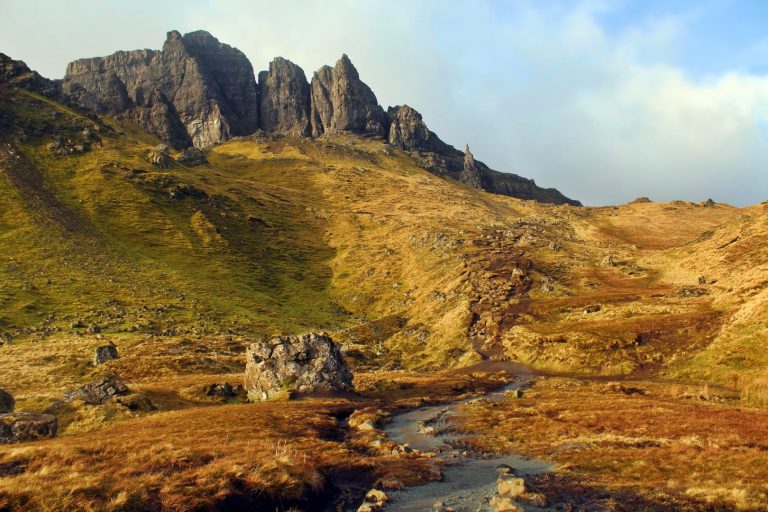

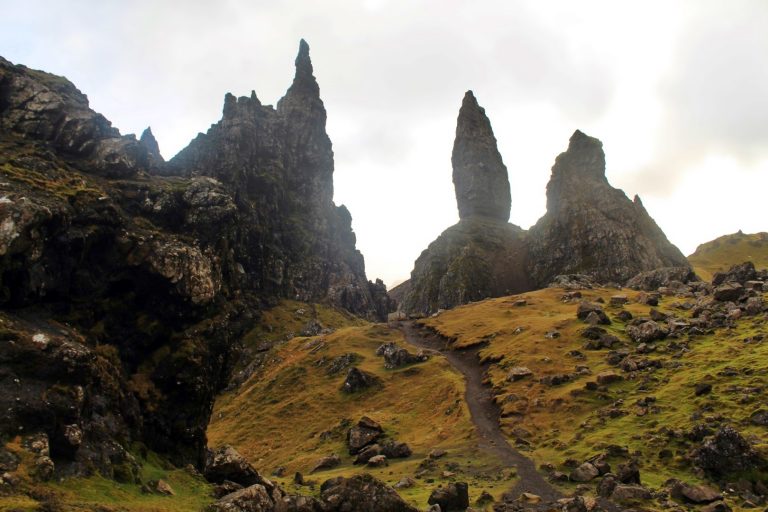
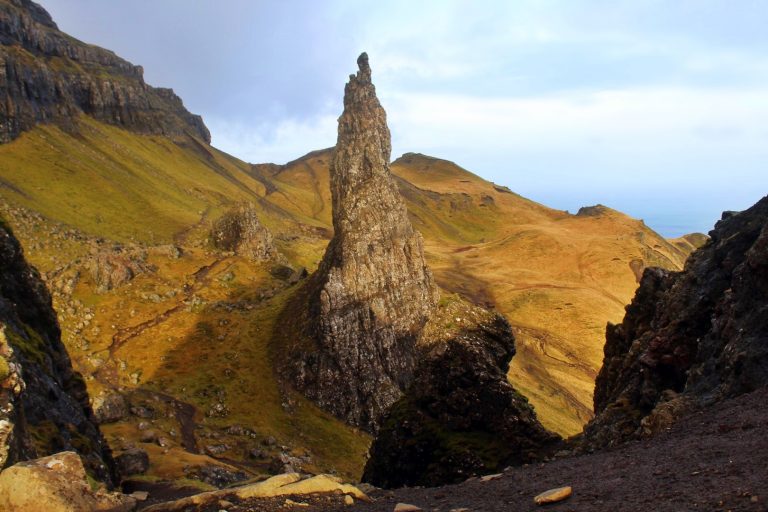
2. Hike out to Brother’s Point
Of all the lesser known spots on Skye, Brother’s Point (or Rubha Nam Brathairean) is my personal favourite!
Brother’s Point is located along the Trotternish Loop and requires an easy 1,5 km hike to reach. The trail to the rocky headland begins in the tiny village of Culnacnoc. There are no signposts along the road, but the path is easy to find as it’s the only path leading down to the ocean. There’s one river to cross along the way, which can be tricky, but going over barefoot does the trick! Take your time and enjoy the majestic landscapes as you make your way to the rocky headland. You might spot seals, and if you’re visiting on a clear day, you can see Kilt Rock, Mealt Waterfall and the mountains of the Scottish mainland in the distance. Eventually, the pinnacles of the Storr will also come into view.
Once you’ve reached the headland, take your time to explore it in depth, and don’t miss out on the opportunity to hike to its end. This is where the views are best!
Read more: Beyond the beaten path on Skye: Lealt Falls and Brother’s Point


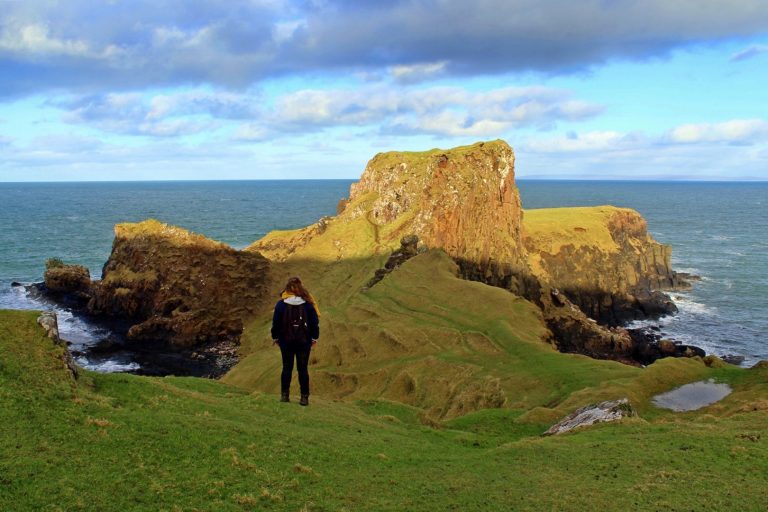
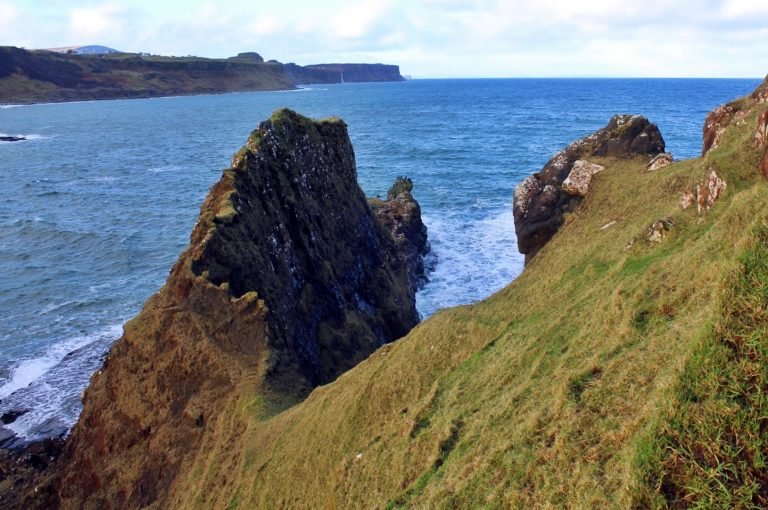
3. View Kilt Rock and Mealt Waterfall
A popular spot along the Trotternish Loop is the viewpoint for Kilt Rock and Mealt Waterfall. These two sights can be seen from the same viewpoint as the waterfall falls right beside Kilt Rock. The latter is made up of basalt columns resting on a sandstone base, and – apparently – resembles a pleated kilt (I personally couldn’t see it, but maybe you have a better imagination than me?).
It’s a nice place with beautiful scenery and an easy stop on your way around the peninsula. It’s also a great place to visit if you’re not keen on hiking!
Read more: Hitchhiking wins and fails around Skye’s Northern Loop
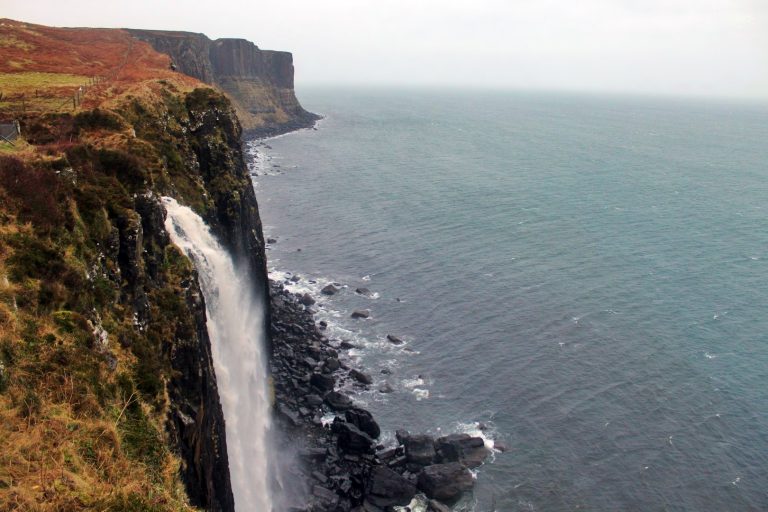
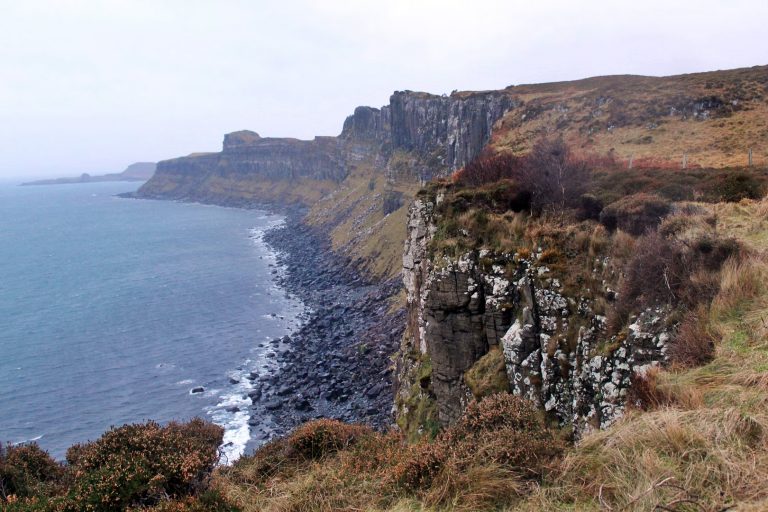
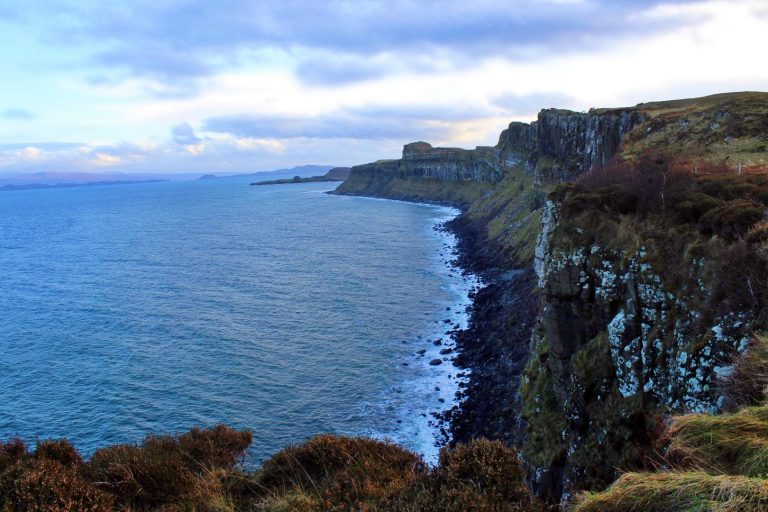
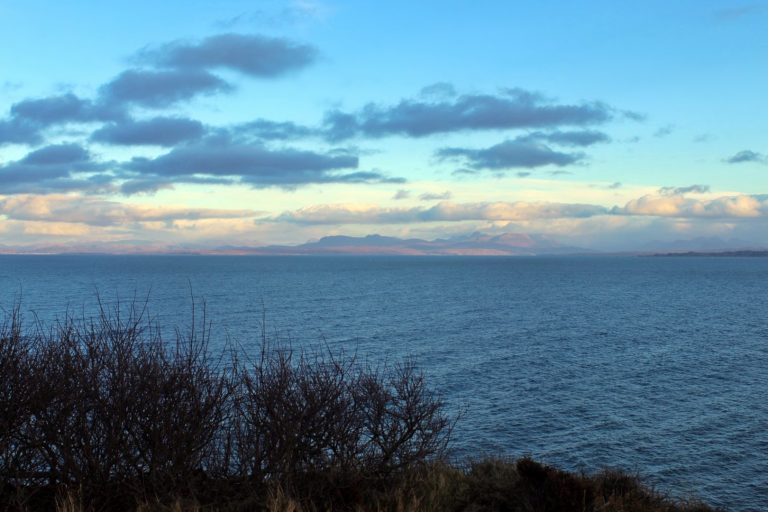
4. Find the dinosaur footprints in Staffin
A unique thing to do with children on Skye is to search for the dinosaur footprints at An Corran beach in Staffin.
These footprints were left by a family of Ornithopods – herbivorous dinosaurs that walked on two legs, some 165 million years ago. The prints are covered by the sea at high tide, and often by sand in the summer, so it’s best to visit this place in the off-season. The footprints can be found to the right of the large boulders. It can be difficult to locate them, so schedule enough time for your visit and don’t be shy to ask if you meet a local on the beach!
Read more: Hitchhiking wins and fails around Skye’s Northern Loop
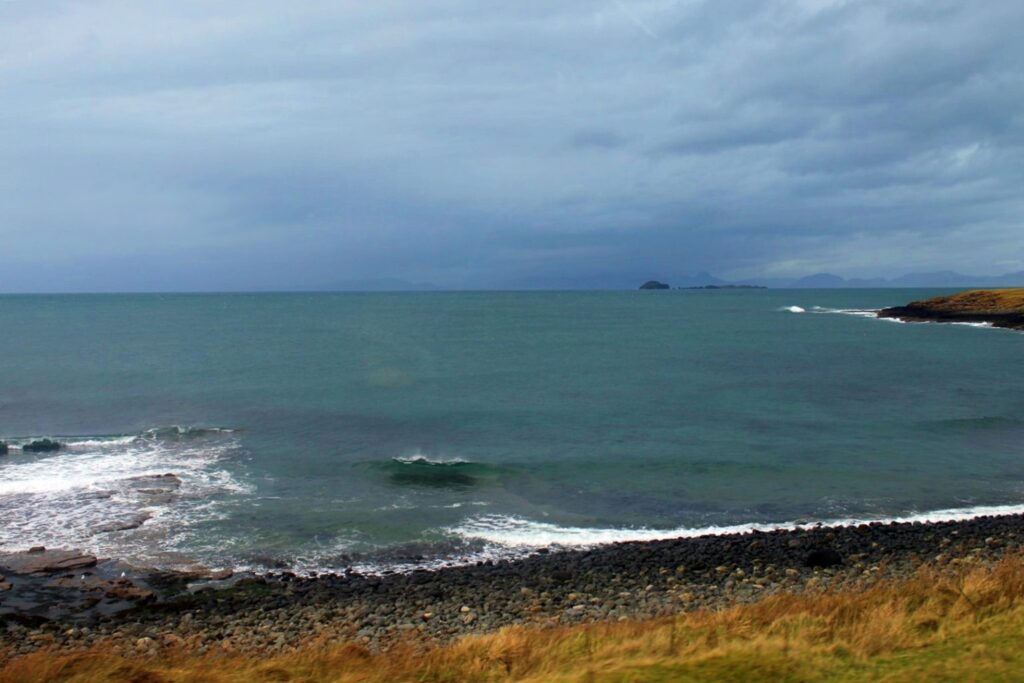
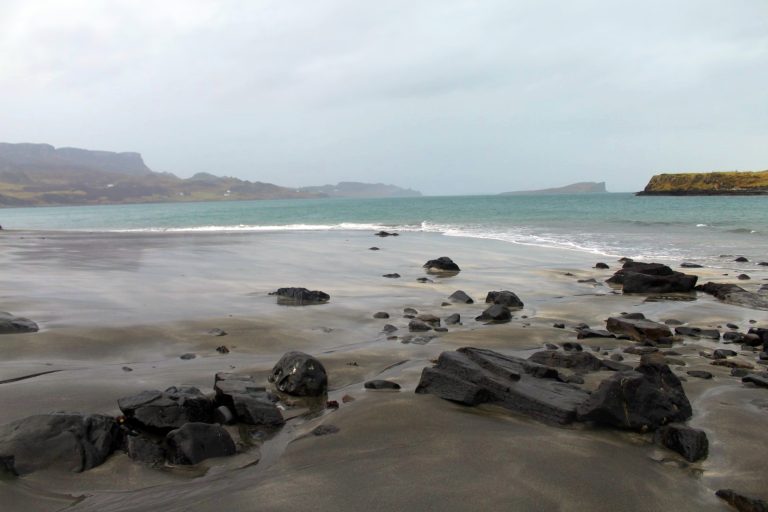
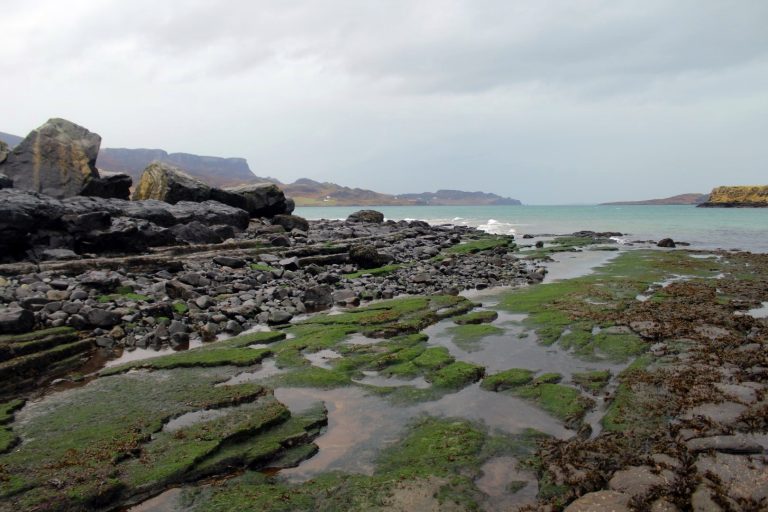
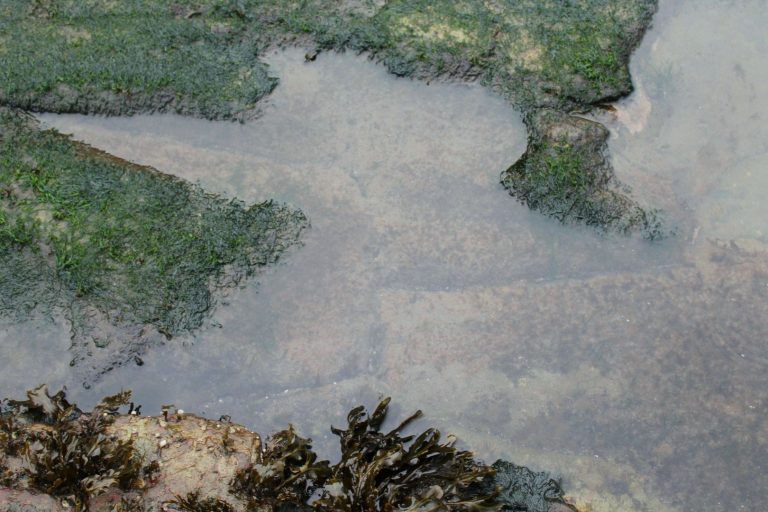
5. Swim in Loch Sheanta
Another well hidden spot on the Trotternish peninsula is the small emerald lake of Loch Sheanta.
For a gorgeous hike down to the lake, start in the tiny village of Dunans and hike downhill towards the ocean. It won’t be long until the gorgeous little lake appears. Like most places on Skye, this lake is a place of legends and myths. It is told that the spring at the north end, found within a small forest, can cure a number of diseases. This spring, along with another to the south, feeds the lake with clear water, which is in parts so crystal clear that the bottom is visible.
Loch Sheanta might just be the best wild swimming spot on Skye – and you’re very likely to have it all to yourself, especially if you visit in the off-season!
Read more: To the heart of the Quiraing: Discovering the secrets of an iconic location
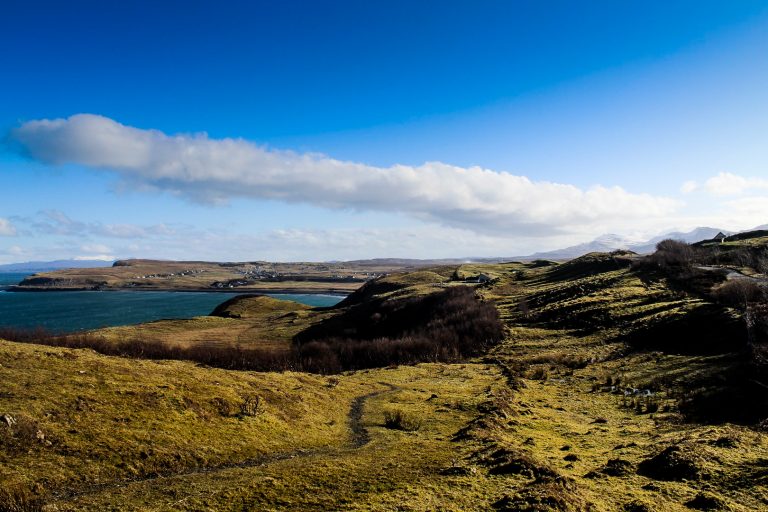

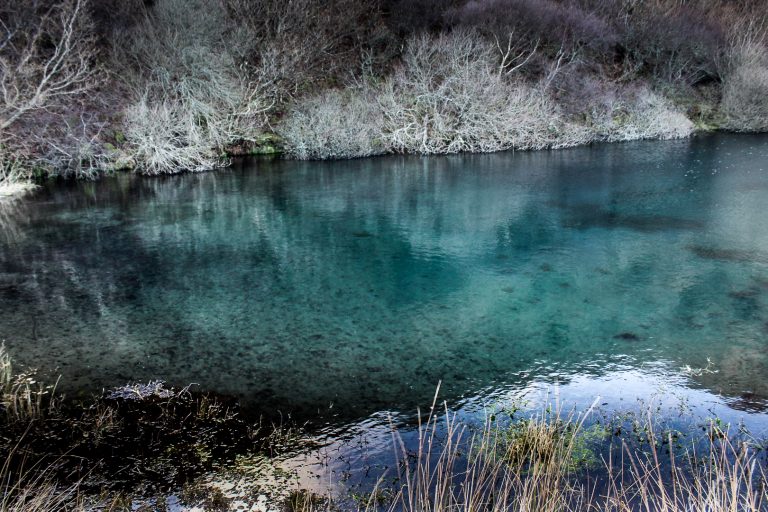
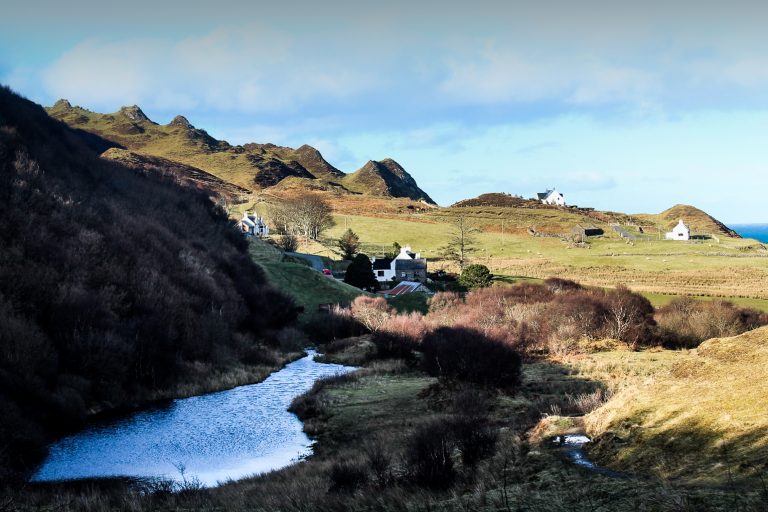
6. Discover the secrets of the Quiraing
Let’s continue with another of Skye’s most famous spots, the Quiraing. But unlike the Storr, where everyone flocks to the same few spots, the Quiraing is full of secrets and hidden places just waiting to be discovered.
The geologically intriguing Quiraing is located on the eastern face of the mountain Meall na Suiramach, which is the northernmost summit of the Trotternish Ridge. This entire ridge was formed by landslides some 175 million years ago, which also created the Storr. But the Quiraing is the only part of it that is still moving! In fact, the landscape is in constant motion, shifting a few centimeters each year, resulting in yearly repairs of the roads. This alone makes the area an interesting place to visit, but it is the gorgeous sceneries with steep cliffs, rock pinnacles and rolling hills that bring in the crowds!
My brother and I joined our friend, Steve, for one of his Quiraing tours on a beautiful day. Steve knows Skye better than anyone else, and in particular the Quiraing, and he knows how to get away from the crowds to some spectacular, hidden spots.
A very popular hiking trail starts at the parking lot, and goes around the mountain in a 6,8 km loop. Most tourists only hike a short section of this path where the most insta-famous view of the Quiraing is found, but the entire circuit is well worth hiking – and beyond, as we were about to discover. When we reached the first of the area’s distinctive landmarks, the Prison, Steve guided us away from the crowds and up the landmark itself to discover some incredible views. According to Steve, you haven’t truly seen the Quiraing if you haven’t been inside the Quiraing! I imagined some secret cave when he told us this, but inside literally meant behind the pinnacles. The few hikers that had joined us all the way to the Prison were had disappeared, now we were completely alone.
Inside the Quiraing, the snow still lay on the ground, the sun’s rays unable to reach through the rocks. The most prominent landmark in this hidden hollow of the Quiraing is the Table, an elevated plateau which once slipped down from the summit plateau of Meall na Suiramach. The table is perfectly flat and level and does, in fact, resemble a giant table. I was in total awe of the beauty found inside the Quiraing, and I must say that it was worth taking a tour to see it. We would never have found it without Steve’s help!
Read more: To the heart of the Quiraing: Discovering the secrets of an iconic location
Interested in exploring the Quiraing in depth? Why not do what we did and go on an incredible tour with Steve and his two adorable dogs? They know all the good spots, and Steve is a wonderful storyteller! Find out more on Steve’s website here.
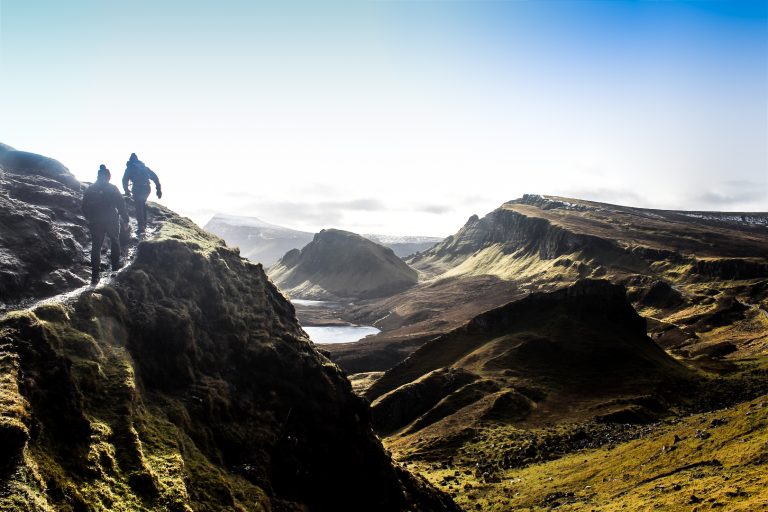

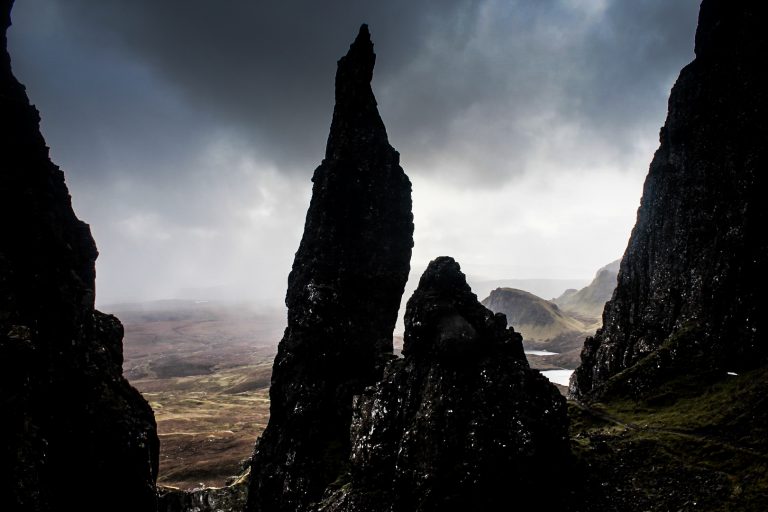

7. Hike to the Northernmost Point on Skye
The Rubha Hunish peninsula makes up the northernmost part of Skye, and it offers endless trails and beautiful views to discover. Hike out to the very end of Skye, get a little lost, or climb the hills Meall Deas (100 m. above sea level) and Meall Tuath (116 m. above sea level) for incredible views over the whole area. Don’t forget to look in the direction of the Rubha Voreven peninsula, too. This was my favourite view!
Rubha Hunish has to be one of the best kept secrets in Skye. Very few tourists even consider hiking here, but it was one of my favourite experiences on Skye. Apparently, it’s also the best place on Skye for whale spotting!
Read more: Hitchhiking wins and fails around Skye’s Northern Loop
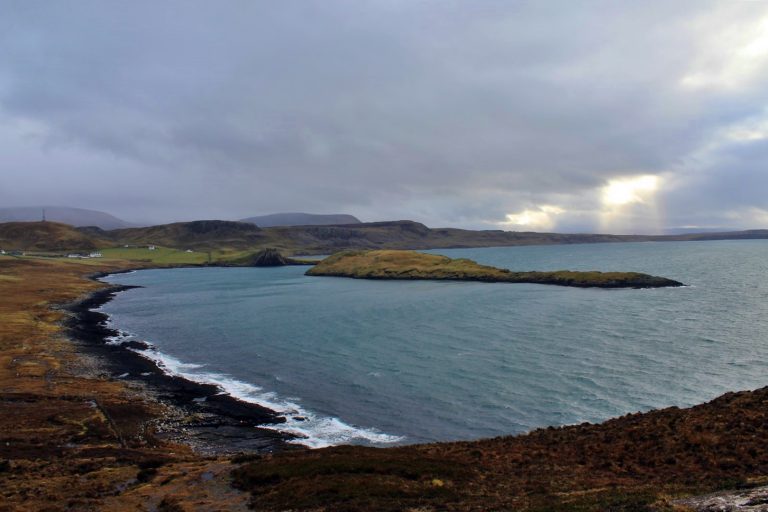
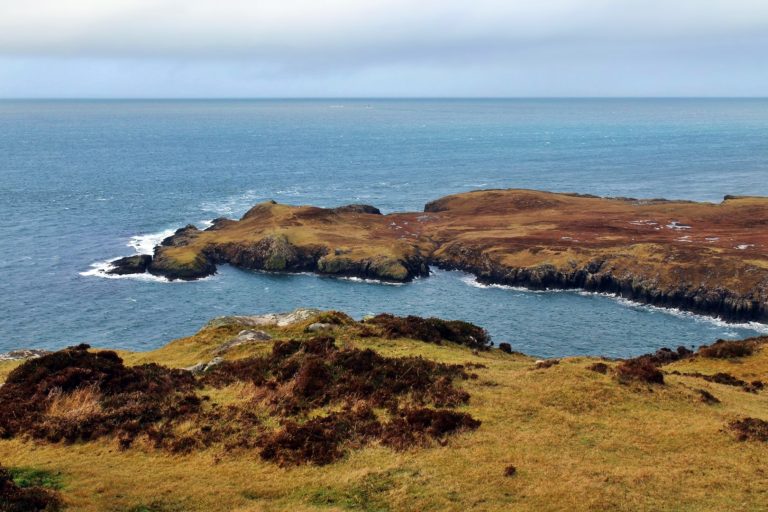
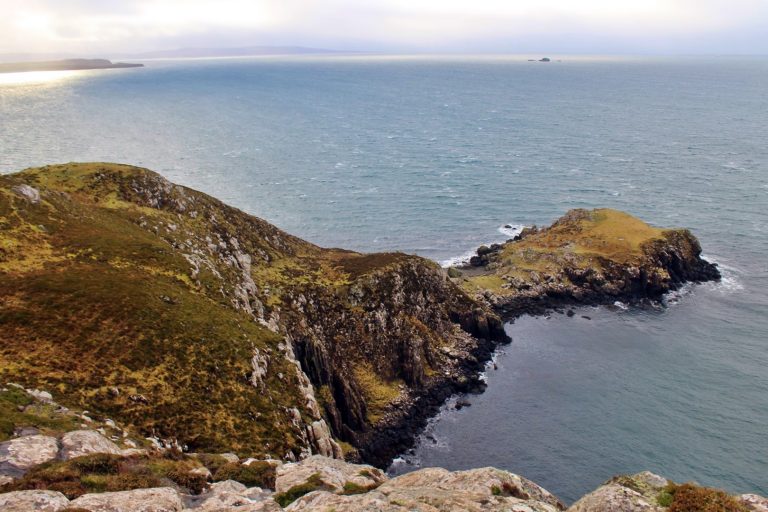
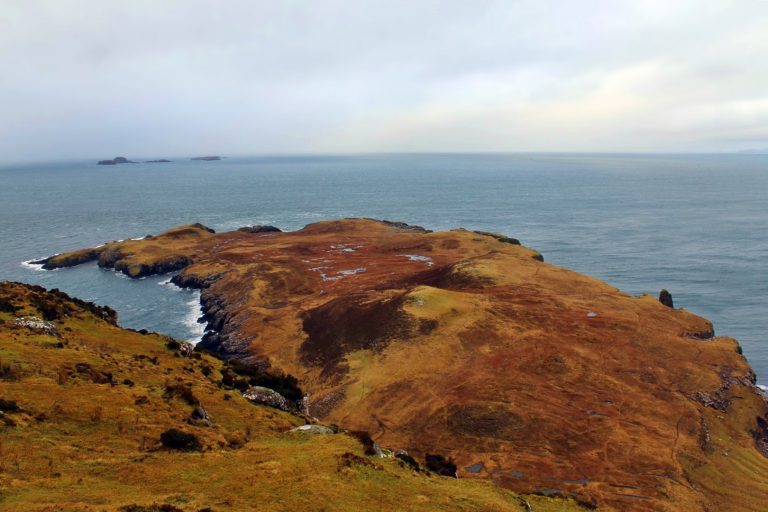
8. Explore the ruins of Duntulm Castle
Take a break from hiking and nature experiences and explore the ruins of Duntulm Castle from the 14th century. The castle was once the seat of the chiefs of Clan MacDonald of Sleat. According to the legend, the castle was abandoned around 1732 after the infant son of a residing chief fell to his death from a window. The infant was in the care of a nursemaid, who allegedly was set adrift on the ocean in a small boat as punishment. The castle is said to be haunted by many ghosts, including that of the nursemaid.
Located on the north end of the Trotternish peninsula on a basalt promontory by the sea, the castle offers not only intriguing history, but also amazing views.
Read more: Hitchhiking wins and fails around Skye’s Northern Loop
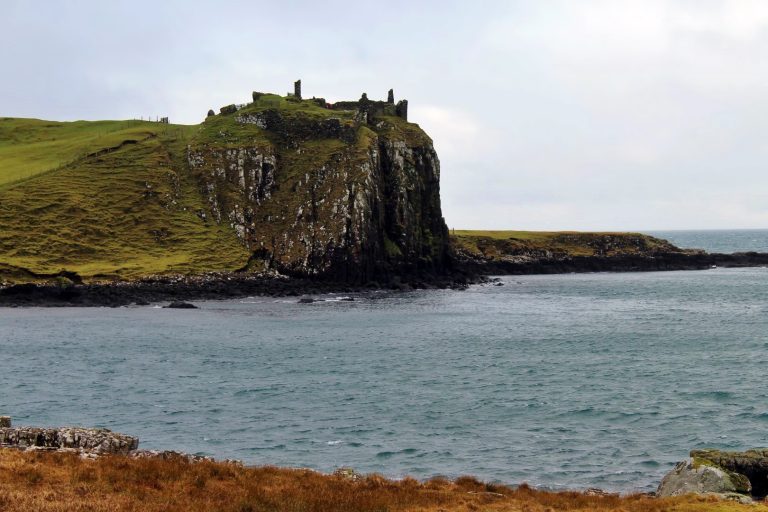


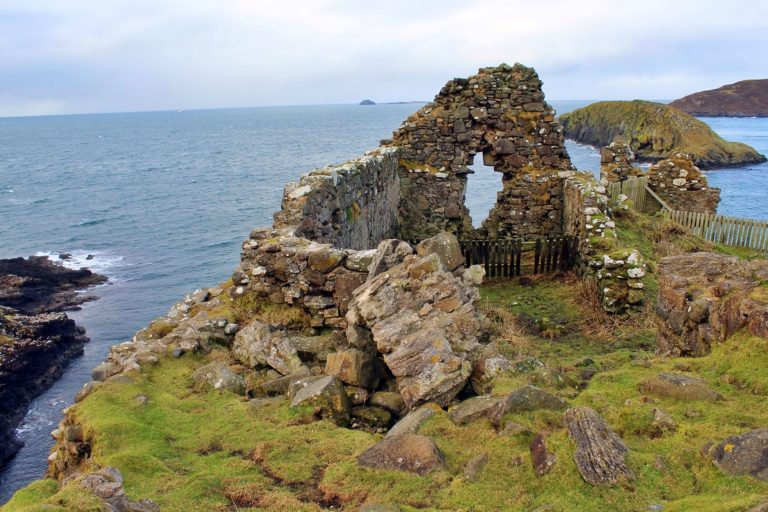
9. Learn about traditional life on Skye
The Skye Museum of Island Life is dedicated to preserving a 19th century township of thatched cottages. Take a step back in time and learn about the fascinating history of the island. It’s a great place to visit if you’re stuck with a rainy day on Skye.
The open air museum is only open during the summer, but it’s still possible to explore the grounds for free in the off-season.
Read more: Hitchhiking wins and fails around Skye’s Northern Loop

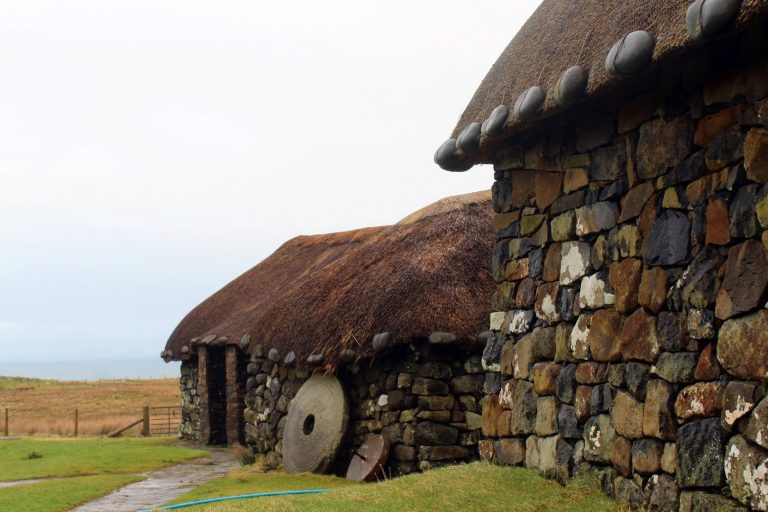
10. Get lost in the Fairy Glen
The Fairy Glen is a unique miniature landscape of grassy, cone-shaped hills created by landslips. Several trails lead through the area, but I’d recommend just wandering as you please and getting a little lost. There’s plenty of beauty to be found off the main trail here. The castle-resembling hill, known as Castle Ewen, dominates the landscape and is the perfect place to get a view of the entire area.
Despite its name, the Fairy Glen has little to do with fairies. No legends or stories about fairies are known from this area, although I can see how this unusual place would be the perfect wishful home of fairies. Unfortunately, as we were told by a local, these false fairy beliefs – or wishes – have resulted in tourists moving rocks to create spirals and cairns to be used in rituals, and tokens are often left behind “for the fairies”. All this does is ruin nature and create litter. It also creates work for the locals as they gather annually to remove the stone spirals and cairns in an attempt to keep the area in its natural state. Let’s all help them by not participating in these silly games (or Instagram schemes). Go by the old saying, ‘take only pictures, leave only footprints’ and enjoy this unique piece of Scottish nature.
Read more: Hitchhiking wins and fails around Skye’s Northern Loop


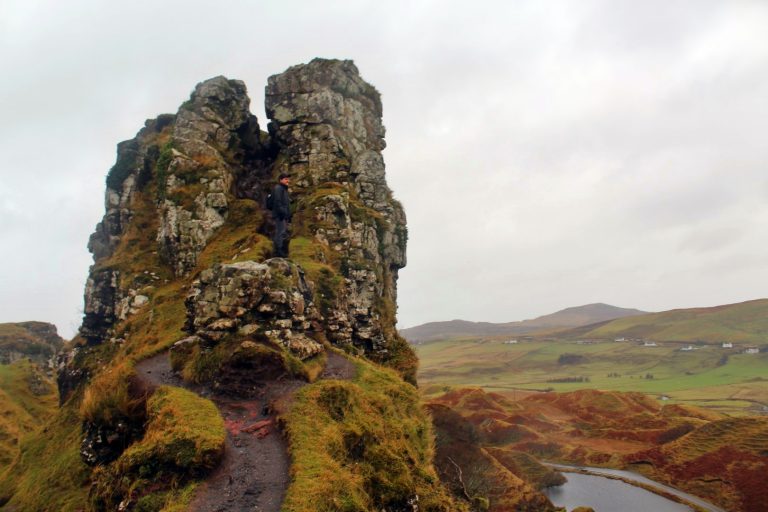
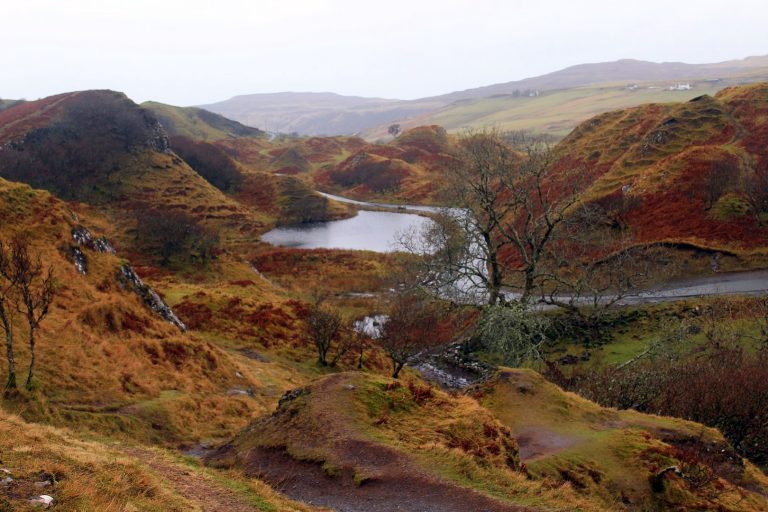
11. Explore the mysterious Saint Columba’s Isle
Saint Columba’s Isle is a tiny historic island located five miles outside of Portree. It may be small and unknown to the masses, but its historical significance stretches back over many centuries; back to when the island was founded by Saint Columba in 1079 and it became the centre of Christianity in the Hebrides to 1498 when the buildings were destroyed during the Scottish reformation. Two visible ruins can be seen on the island, as can hundreds of graves of bishops, chiefs and Skye residents, ranging in age from the 11th century to the 1960s.
It’s an interesting and eerie place to explore, and a perfect place to go on a rainy or foggy day.
Read more: Hitchhiking wins and fails around Skye’s Northern Loop
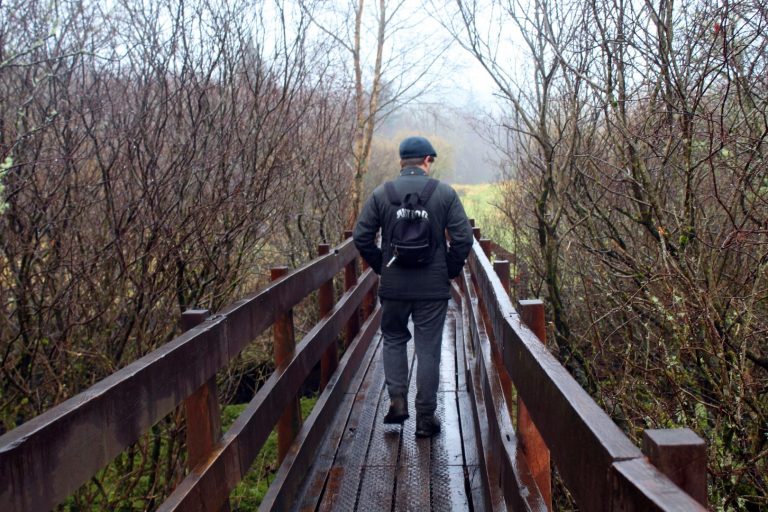


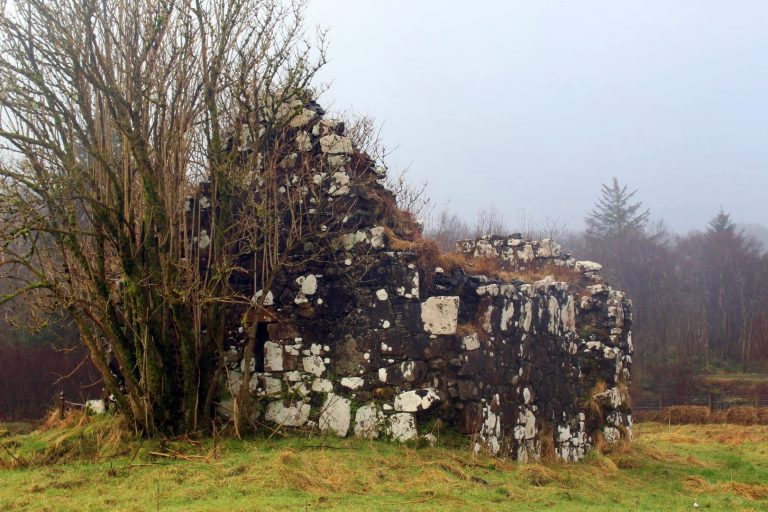
Portree area
12. Visit Portree, the main town on Skye
Portree was the town I lived in while on Skye, and it’s the area I know the best. Portree isn’t just any ol’ town, it’s the “capital” of Skye, and also a cute little spectacle with colourful townhouses and a lively harbour. If you’re looking for a place to have lunch or dinner, Portree offers plenty – and it’s easy to find vegan food, too!
The town of just over 2,300 people is usually only visited for a quick meal or a night’s sleep, but it’s worth spending some time getting to know Portree. The colourful harbour, fringed by high cliffs, is a beautiful sight, and the view from the Apothecary’s Tower is not to be missed. You can also take a walk along the black sand beach, from where the tiny islet of the Black Rock can be reached at low tide.
My favourite short walk in town is the Am Meall path which circles the Lump, a rocky outcrop by Portree’s harbour. The trail offers gorgeous panoramic views over Portree, the island of Raasay and the Cuillin Mountains in the distance. You can also take a stroll through the Glen Varragill forest above the Aros Centre, or go for a longer hike on the Scorrybreac (see below) or to the black sand beach of Camas Ban (see below).
Read more: Five beautiful hikes in Portree, the capital of the Isle of Skye
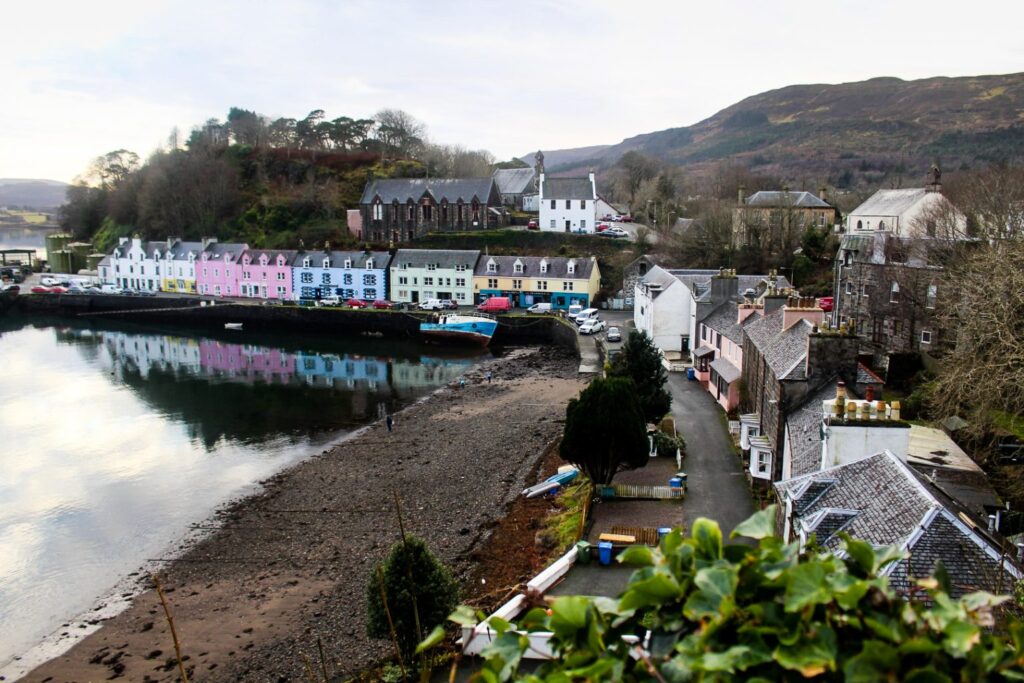

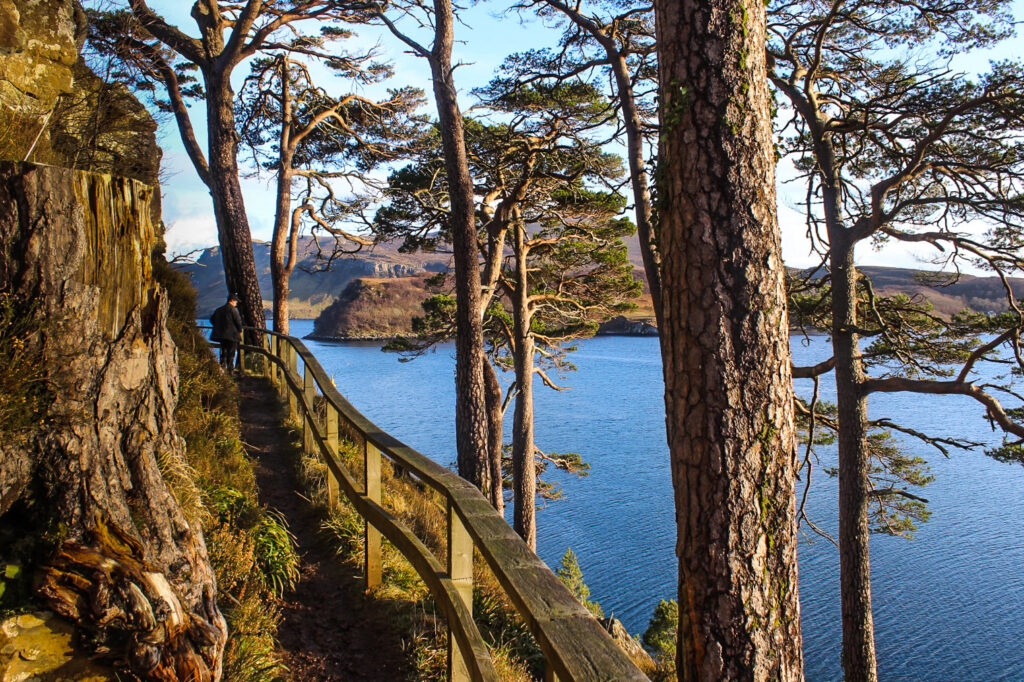
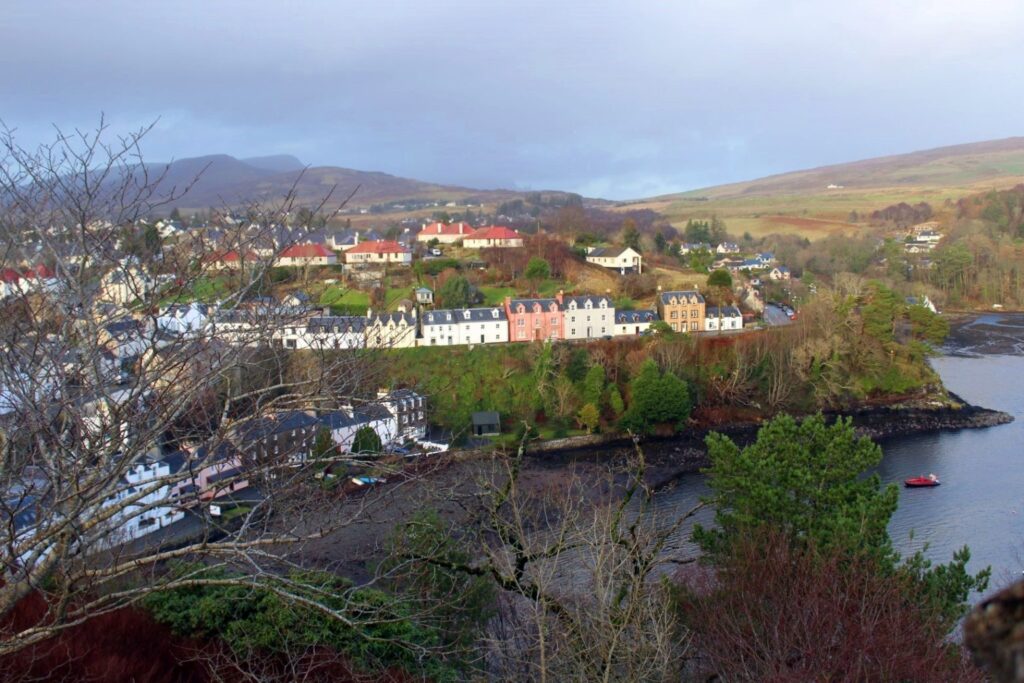
13. Explore the hiking paradise of Scorrybreac
The Scorrybreac circuit is a wonderful short hike of about three kilometres on well-trodden paths, just north of Portree. The paths get quite muddy after rain, but it’s a really easy hike with just a few steep yet short ascends. The circuit offers incredible views throughout, southwards to Portree with Ben Tianavaig and the Cuillin Mountains in the backdrop and northwards to the pinnacles of the Storr. In the near distance to the east, you can see the gorgeous island of Raasay.
The circuit hike takes around an hour, but you can also choose to explore the Scorrybreac further. For example, you can hike to the top of the hill that the circuit circles and hike back town to the tiny village of Torvaig and then back to Portree. This makes for a nice and easy hiking day with beautiful views throughout.
Read more: Skye’s Scorrybreac, a hiking paradise near Portree
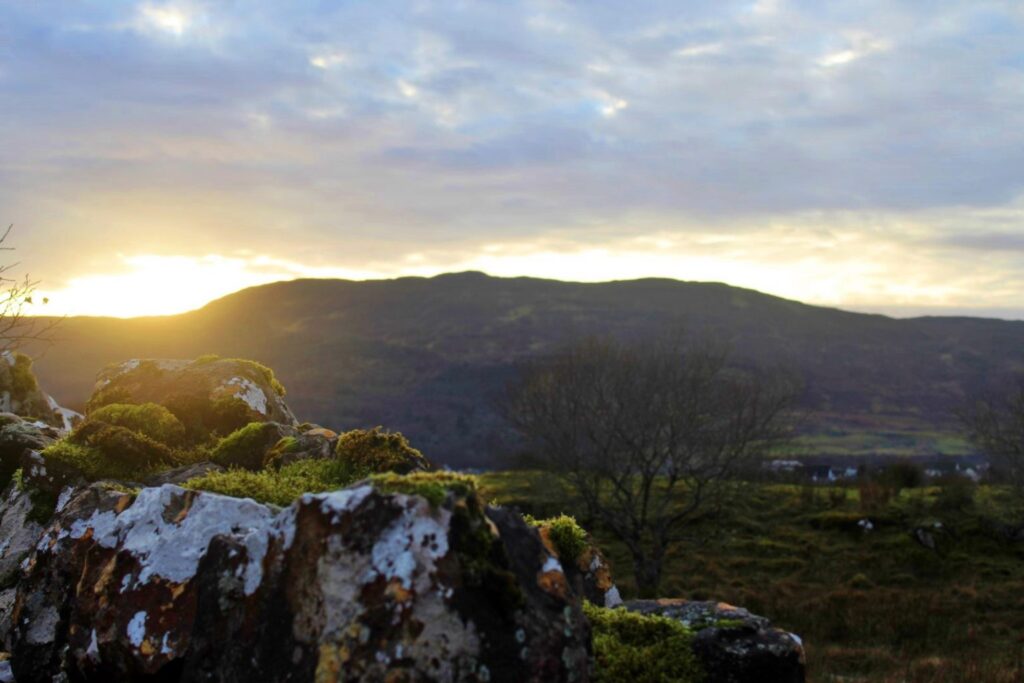

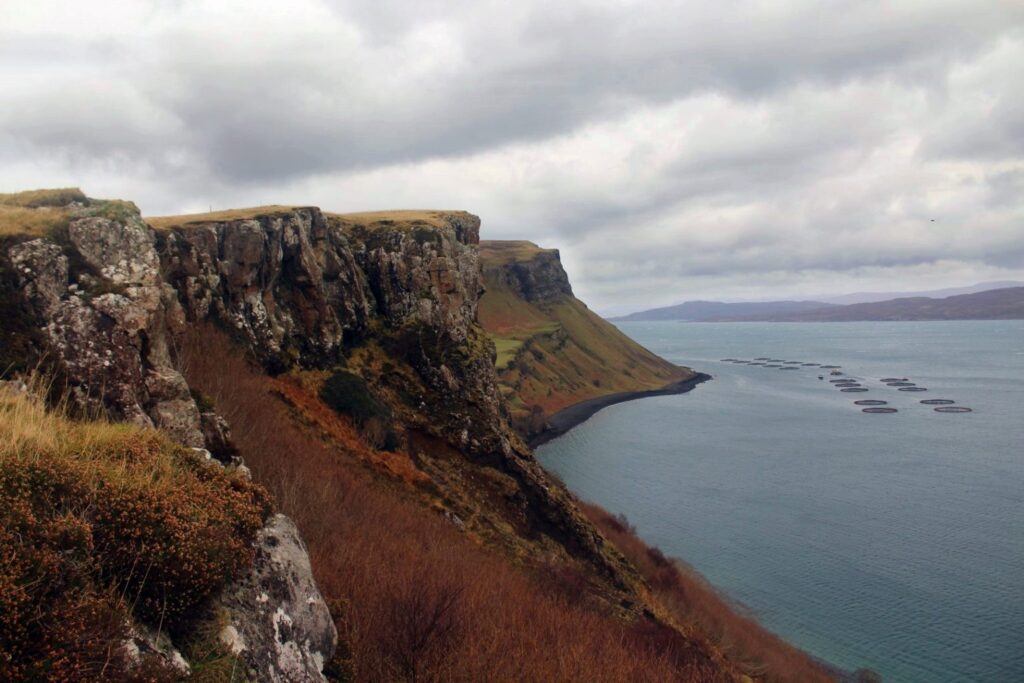

14. Hike to Camas Ban, a hidden black sand beach
Another of Skye’s best kept secrets is Camas Ban, a black sand beach near Portree. Because of its isolated location, this is a place you’re sure to have to yourself – unless a local decides to stop by, too.
There’s no official trail to the beach, but I’ve described the 4 km route we took in the blog post below. The route also takes you past an old house known as the Faraway House due to its location at the end of the world (well, almost!). You might get lucky and spot some seals there like we did!
At the beach, take your time to explore. Touch the silky sand, enjoy the views, and see if you can find a little rock pool that resembles the turquoise Fairy Pools (hint: it’s found at the edge of the beach!).
Read more: Hidden Skye: A hike to the beach behind the Faraway House

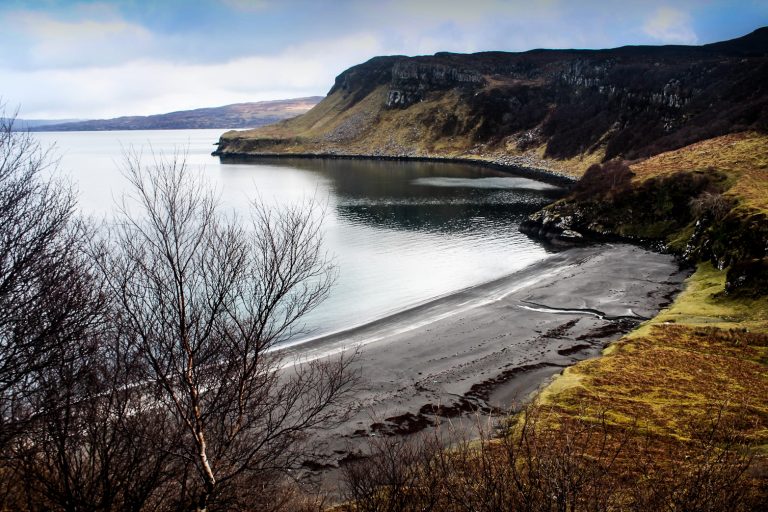
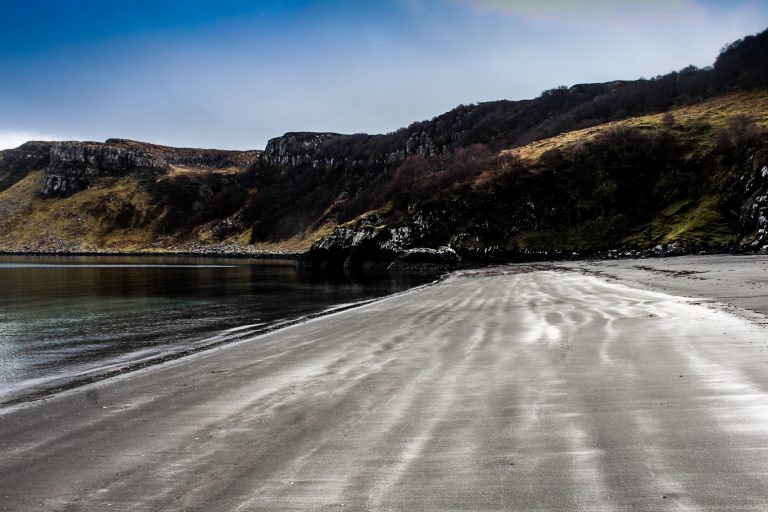
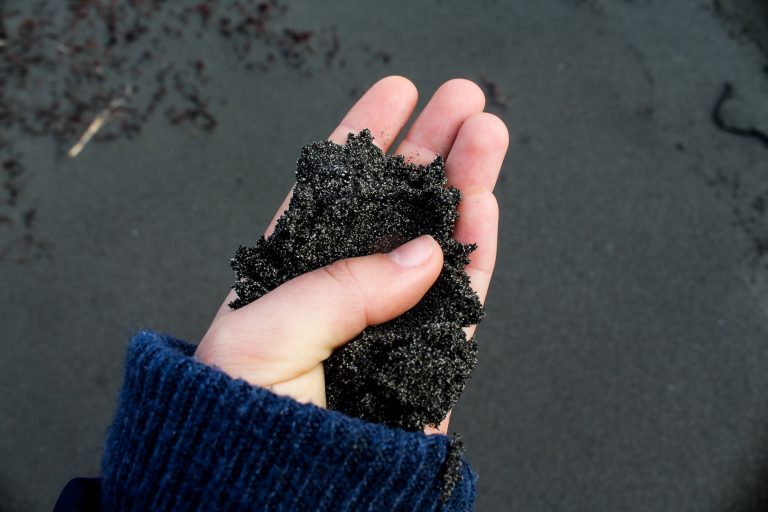
15. Climb Ben Tianavaig
Ben Tianavaig is a low mountain near Portree and it offers one of the easiest hikes on Skye with brilliant views over the Sound of Raasay, the Red Hills and Cuillin Mountains, the Trotternish peninsula with the Storr and of course Portree with its colourful harbour.
The trail up Ben Tianavaig begins in the village of Camustianavaig in the Braes, and it takes just 2-3 hours to reach the 413-metre-high summit, allowing for plenty of time to photograph the beautiful surroundings. The ascent is gradual and easy for most. If you’re not big on hiking but still want to experience Skye from above, hiking up Ben Tianavaig is a great choice!
Read more: First hike on Skye: To Camustianavaig and Ben Tianavaig
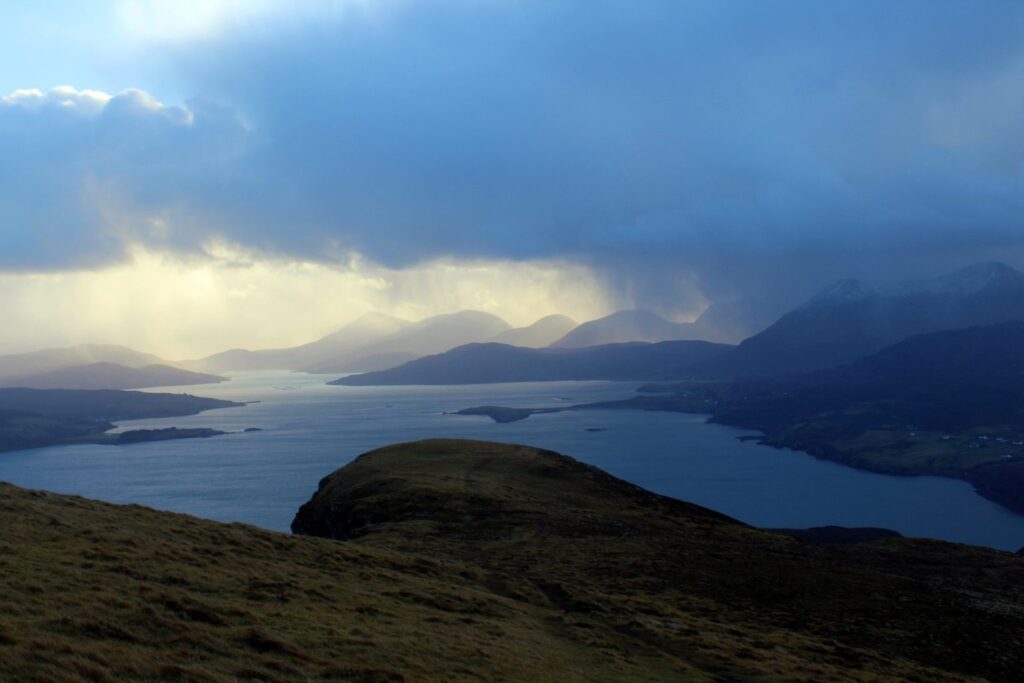
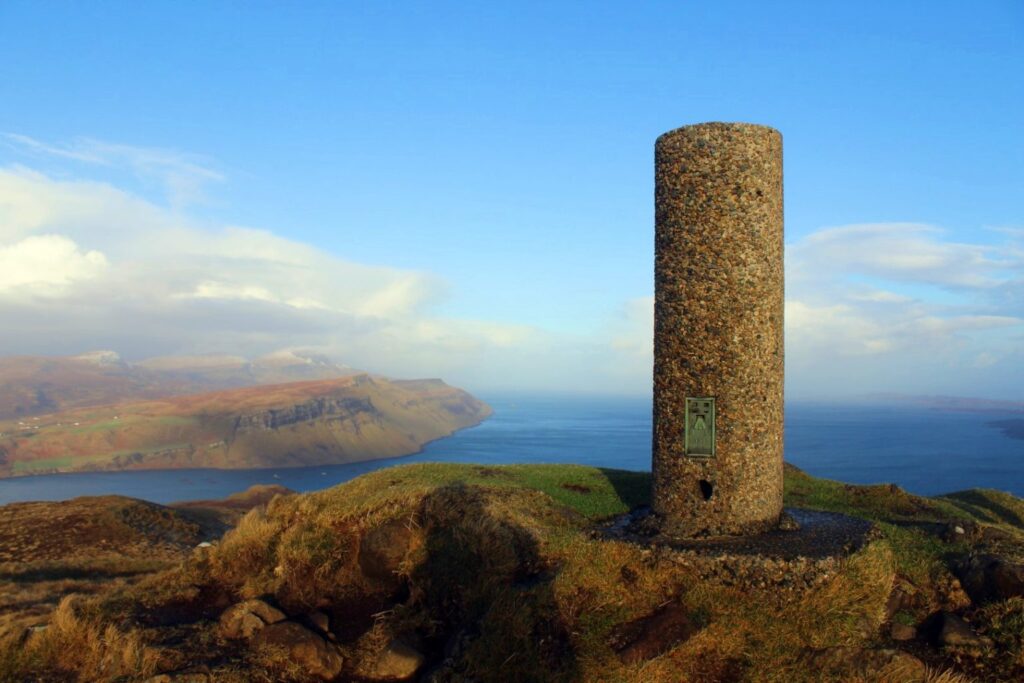
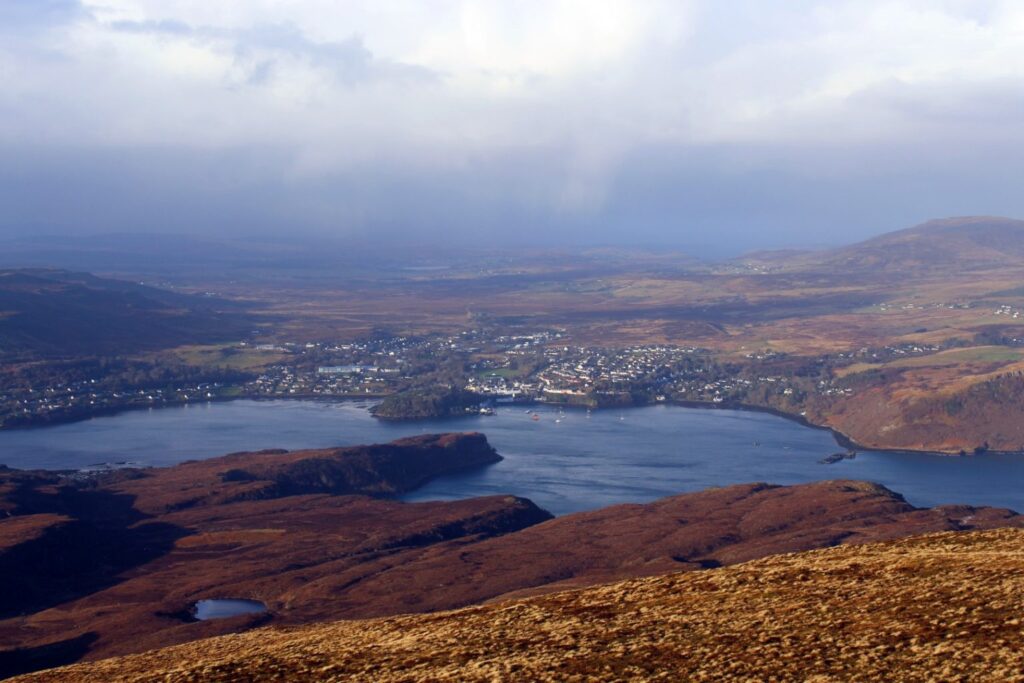

The rest of Skye
16. Walk over the Skye Bridge
What better way to arrive on Skye than to walk over the Skye Bridge?
Catch a bus or drive to Kyle of Lochalsh on the mainland, and then spend your time crossing the bridge over Loch Alsh, a wonderful 45-minute walk, taking you over the tiny island of Eilean Bàn, used as a stepping stone for the bridge.
The island was originally home to the lighthouse keepers and their families, but it later became the last home of the famous author, Gavin Maxwell. Today, it is uninhabited, but it is owned by the Eilean Bàn Trust who run it as a nature reserve and rent out the cottages to tourists. Unfortunately, it’s not possible to explore the island without renting a cottage, but you will get some pretty great views over the cottages and the Kyleakin Lighthouse from 1857 as you cross over the bridge above the island.
Read more: Over the bridge to Skye: Eilean Donan Castle and the two Kyles
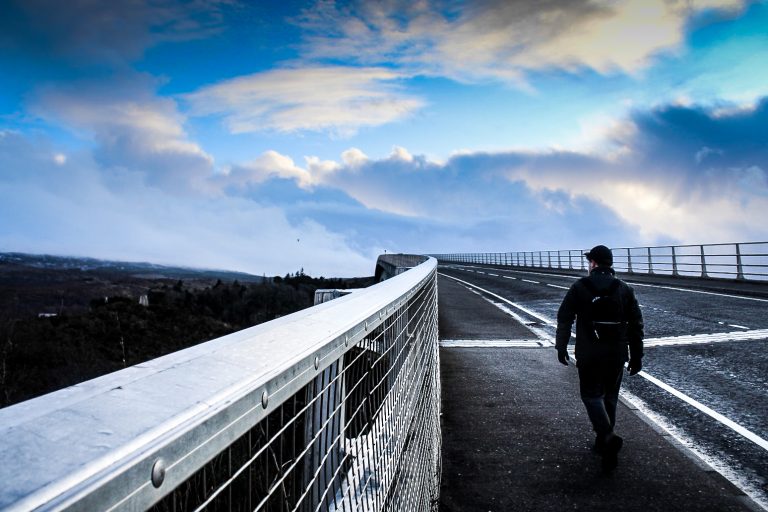

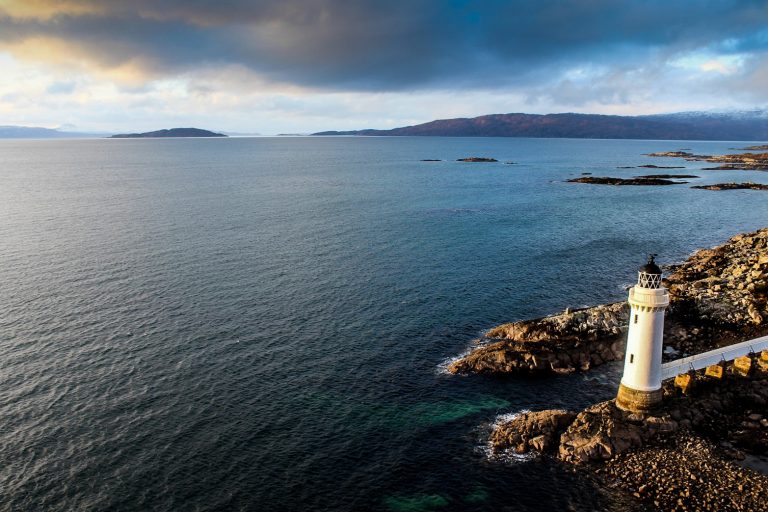
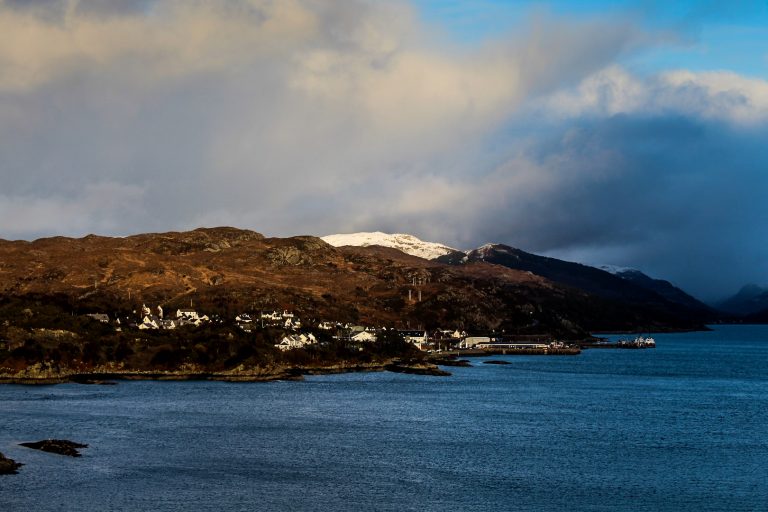
17. Discover the secret beach and peninsula
Here’s a real local secret that shouldn’t be missed if you enjoy going off the beaten path. The place is located near An Aird.
My brother and I explored the place with our friend Steve and his two dogs. We had no idea where we were going beforehand, but as soon as we arrived, we understood why Steve keeps the place a secret. It’s absolutely breathtaking.
He took us on a walk along a sandy beach to a small loch, and then we climbed onto a tiny peninsula, which is separated from the mainland of Skye by a narrow isthmus. From the top of the peninsula, the views all around were amazing. The Isle of Raasay to the east, the snow-capped mountains of the Cuillin to the south, and the rugged side of Ben Tianavaig with the Storr in the backdrop to the north. As we stood there staring in awe, a seal caught our attention as he popped his head above water as if to say hi.
We walked out to the northern tip of the island, stopping every once in a while to hear Steve’s stories about certain rock formations, including the natural three-seater rock formation known to Steve as ‘Fred Flintstones Bench’. Steve has done this walk so many times and knows every corner of the peninsula. Before heading back, he wanted to show us something that would get all the tourists flocking to the place if only the tour companies knew about it. Along the coastline were hidden sea caves, a free-standing pinnacle and a giant blow hole as well as the tiniest natural arch I’ve ever seen!
Read more: Undiscovered Skye: A walk to the secret beach and peninsula
Interested in exploring the secret beach and peninsula? I can’t tell you the exact location as I’ve promised Steve to keep it a secret, but I do recommend doing a tour with Steve to this magical place. His tours are inexpensive, include two amazing dogs and a passionate and knowledgeable guide. Find out more on Steve’s website here.



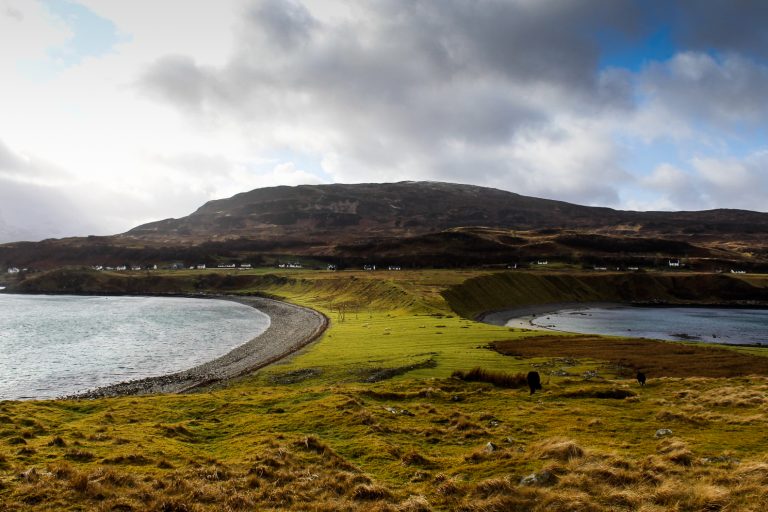
18. Hike through the Cuillin Mountains to the Fairy Pools
The Fairy Pools are another of Skye’s most popular tourist destinations, known for their crystal clear blue and green waters and fairy legends. The majority of visitors walk to the Fairy Pools from the car park, a mere 1,2 kilometer walk, but there’s a more adventurous way to get there! Instead of following all the other tourists, take a 9 km hike from Sligachan through the majestic Cuillin Mountains to the Fairy Pools!
The hike begins just left of the main road in Sligachan, and goes past a small bridge and a beautifully located house. Then follows an easy trail with a gradual ascend into the Cuillin Mountains, passing by waterfall after waterfall until you reach the turquoise Fairy Pools. The hike takes 2-3 hours one way, and you can choose to either hike back the same way or hitchhike back! Once you’re at the Fairy Pools, take your time to explore, hike to the highest pool for the best view and perhaps go for a swim!
To be honest, I personally think the Fairy Pools are overrated. They ARE beautiful, especially with the backdrop of the Black Cuillin ridge, but don’t get fooled by the pictures you see online (looking at you, Instagram!). The water is not as blue or green as photoshopped pictures will have you believe, and the waterfalls are tiny. I think it’s the name of the place that drives tourists in. Go to the Fairy Pools knowing that it won’t blow you away, but will be a nice day out. If you really do want to go, go via the trail described above. It made the experience so much better!
Read more: Hiking to the Fairy Pools through the Cuillin Mountains
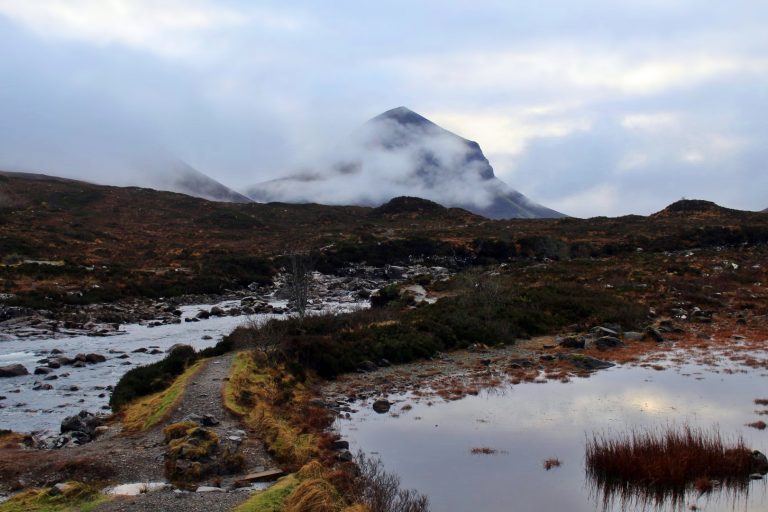

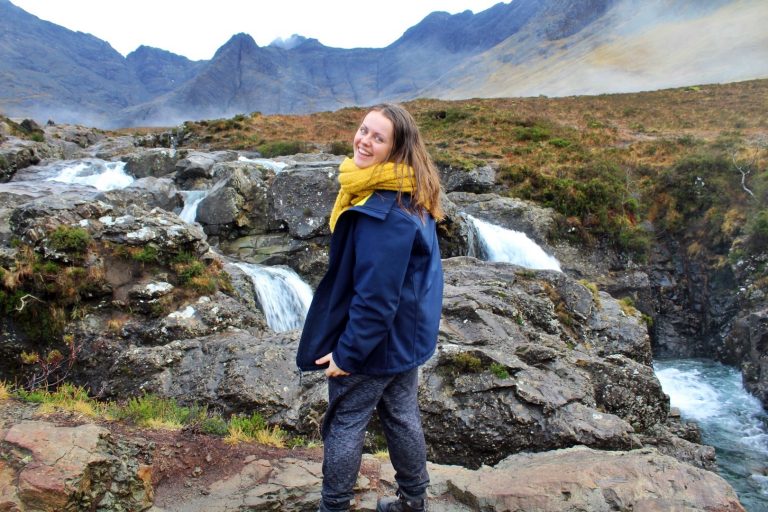
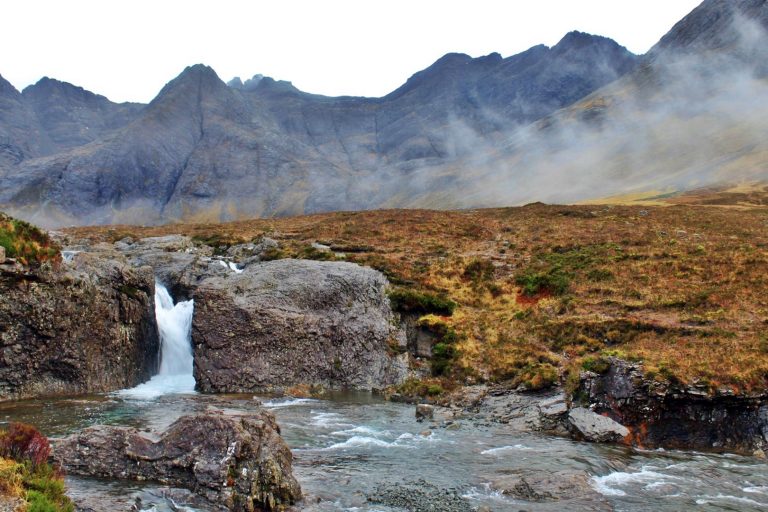
19. Visit Claigan Coral Beach
Claigan Coral Beach is known as one of Skye’s most beautiful beaches. Despite its name, the beach is not actually made from corals, but from fossilised and sun-bleached Red Coralline algae which comes from the tidal island of Lampay where it grows 1 mm per year.
The beach is located in the north of Skye by the small crofting community of Glen Claigan, about seven kilometers from Dunvegan Castle. From the parking lot, there is an easy trail with a few short ascents to the beach. It takes around 30 minutes to complete, and offers lovely views of the unusual landscape of tiny islands and rolling hills in the distance. The beach will come into sight when you cross over a small hill. I have to admit that I was a little disappointed when I saw it; I was expecting a coral-red beach but it looks like any other white sand beach from afar. However, it is truly unusual when you get up close to the Coralline algae.
Climb up the 28 meter high hill, Cnoc Mór a’ Ghrogain, behind the beach for the best view, and if you’re visiting at low tide, why not walk to the tidal island of Lampay for some more exploring?
Read more: An afternoon visit to Dunvegan and Coral Beach



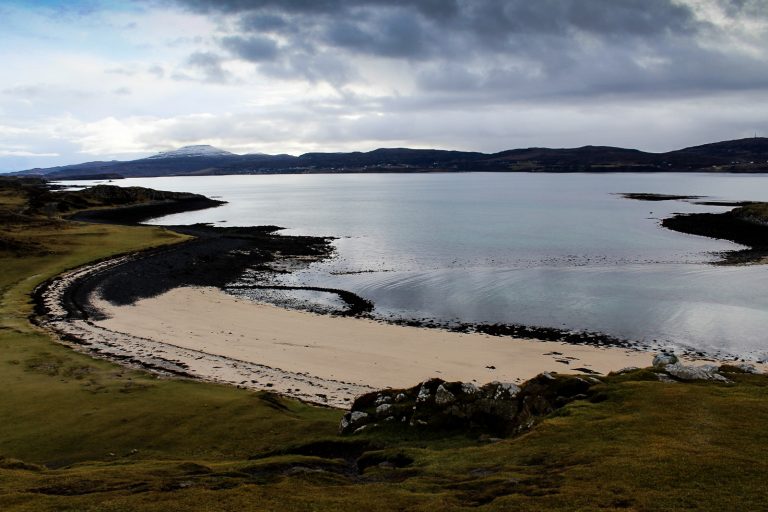
20. Hike out to Neist Point Lighthouse
Last but definitely not least is Neist Point Lighthouse, located on the westernmost point of the island, one of Skye’s most famous spots – especially for sunrise and sunset. But even on a rainy day in winter, the isolated lighthouse with the gorgeous location didn’t disappoint!
The walk out to the lighthouse is short and easy along a concrete path. You’ll get to enjoy wonderful views of rugged shorelines and dramatic cliffs, but the view that everyone wants to see (you know, that postcard-perfect view of the lighthouse at the end of the cliffs) is actually found off-path near the edge of the cliffs halfway to the lighthouse.
The lighthouse and the adjoining complex of keeper’s cottages were built in 1909. But while the lighthouse is still in operation, the keeper’s cottages have been abandoned for several years. After the lighthouse became automated in 1990, the keepers were withdrawn and the keeper’s cottages were sold to a private owner who turned them into a bed and breakfast. However, it’s unknown how long the bed and breakfast was in operation, but it was obvious that it had been abandoned for several years. We did a bit of urban exploration while we were there as we could fit through a broken window, and I urge you to do the same if you’re alone out there!
Before driving off again, walk up a small hill a couple of hundred metres to the right of the car park. This is where you’ll find the most famous view of the lighthouse!
Read more: To the end of Skye: A rainy day out at Neist Point Lighthouse
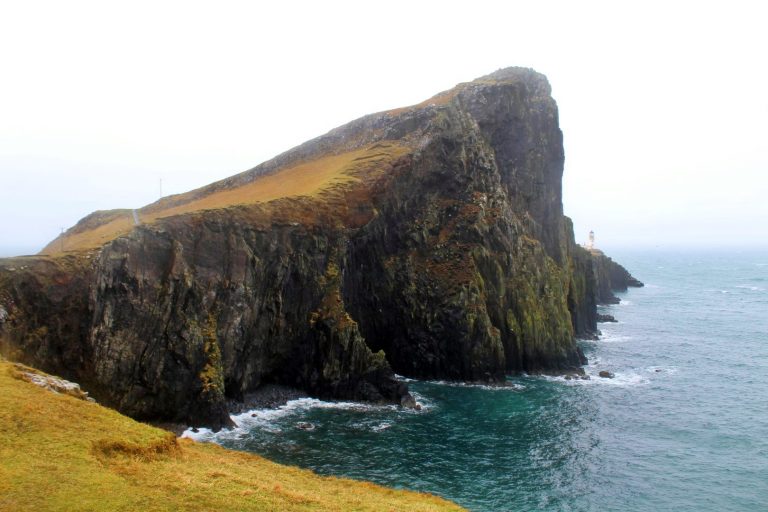


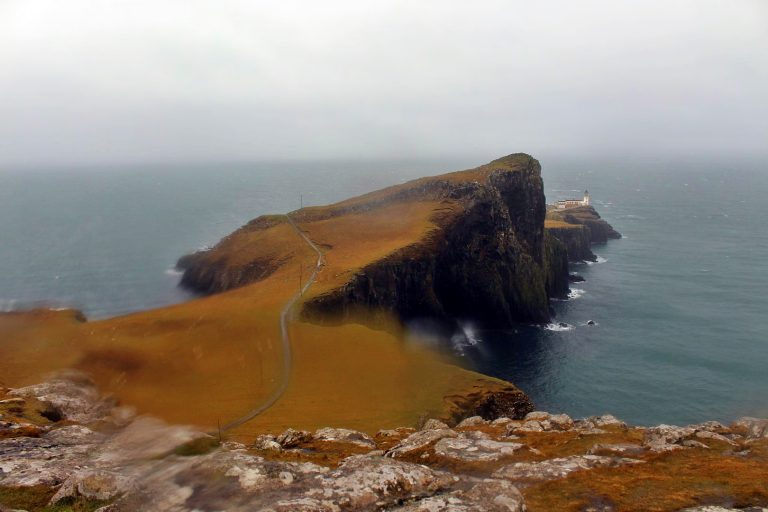
Further exploring on Skye
As you might’ve noticed, there are a few amazing places I haven’t mentioned in the post above, but that’s because I never got the chance to visit them. Once I do, and if I love them, I’ll include them to the list. But until then, maybe you can visit them instead? The places I still want to visit on Skye are as follows:
- The fishing village of Elgol with the Honeycomb Rock
- A boat ride on Loch Coruisk
- Dunvegan Castle
- Armadale Castle
- Castle Moil in Kyleakin
- Climb the twelve Munros in the Cuillin Mountains
- The abandoned village of Boreraig
Please let me know in the comments if I’m missing any must-see places or beautiful local secrets!
Getting around on Skye
Getting around on Skye can be tricky without a car. Hitchhiking is quite easy, especially in the summer months, but you’ll have to allow for plenty of time for each destination. An alternative is taking busses, but they only connect to the largest towns and villages on the island, and are not very frequent. The Walkhighlands website is an excellent source for figuring out how to reach hikes with public transport.
Click here to read more on transportation to and around Skye.
Travelling to Skye as a vegan?
Don’t worry, it’s not as difficult as you might think! Read my guide to veganism on Skye here!
Where to next?
The island of Raasay is one of my favourites in the whole world, and it’s just a short ferry ride away from Skye! My brother and I spent a weekend there, and we absolutely loved it. Raasay is also the best place to see Skye – the view is magnificent!
We also spent a week exploring the islands of the Outer Hebrides: Lewis and Harris, the Uists, Barra and Vatersay. Especially Lewis and Harris and North Uist were incredible. The former can be reached by ferry from Skye, the latter from Lewis and Harris!
Here are my blog posts on Skye’s neighbouring islands:
- Two days on Raasay, my favourite island in Scotland
- Over the sea to Lewis and Harris, the heart of the Outer Hebrides
- Rocky, rugged and remote: The surprising beauty of the Uists
- A trip to Barra and Vatersay, the southern end of the Outer Hebrides
Leave a Comment
Pingback: My 20 favourite new destinations of 2020 – Northtrotter on 02/09/2022
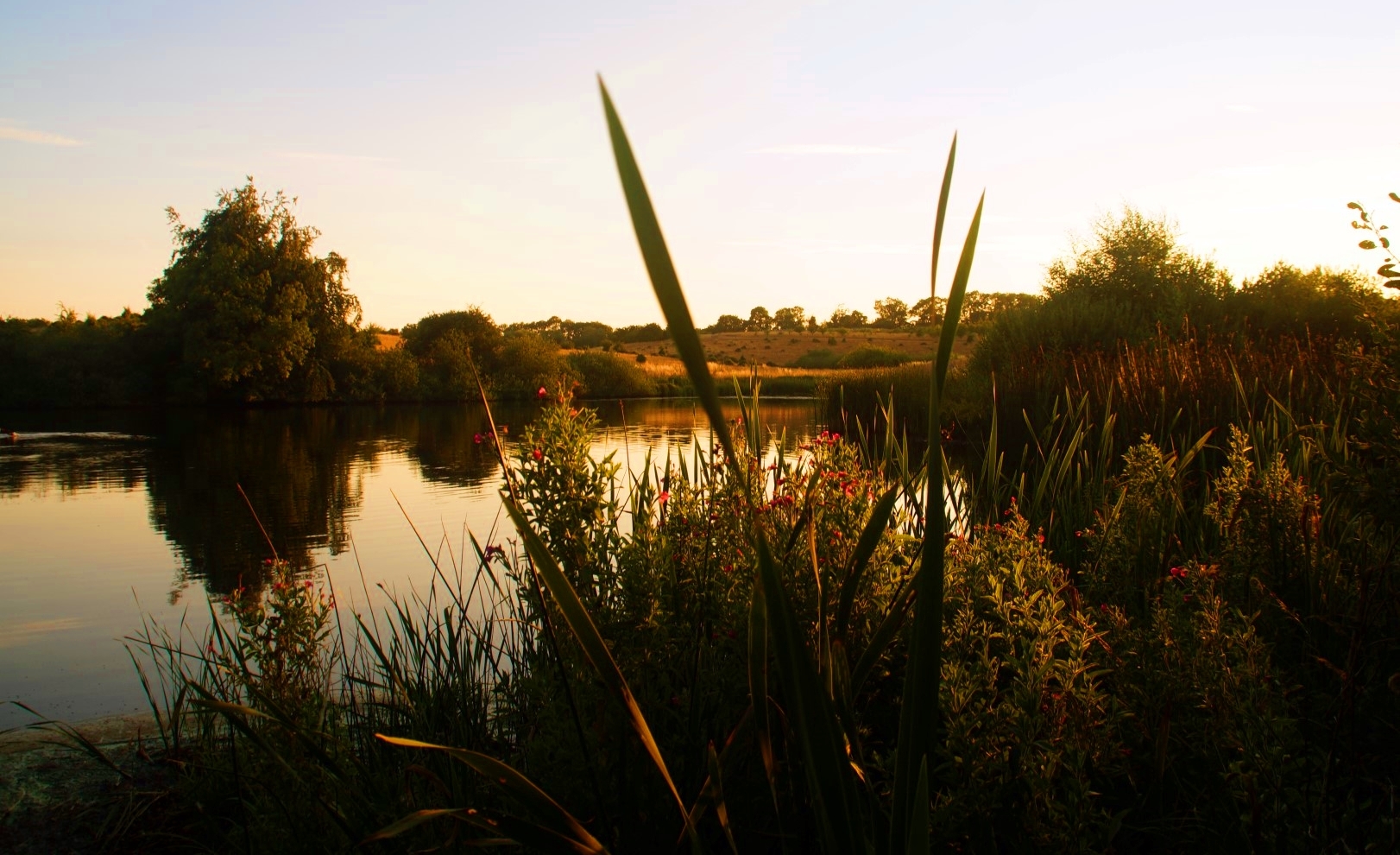
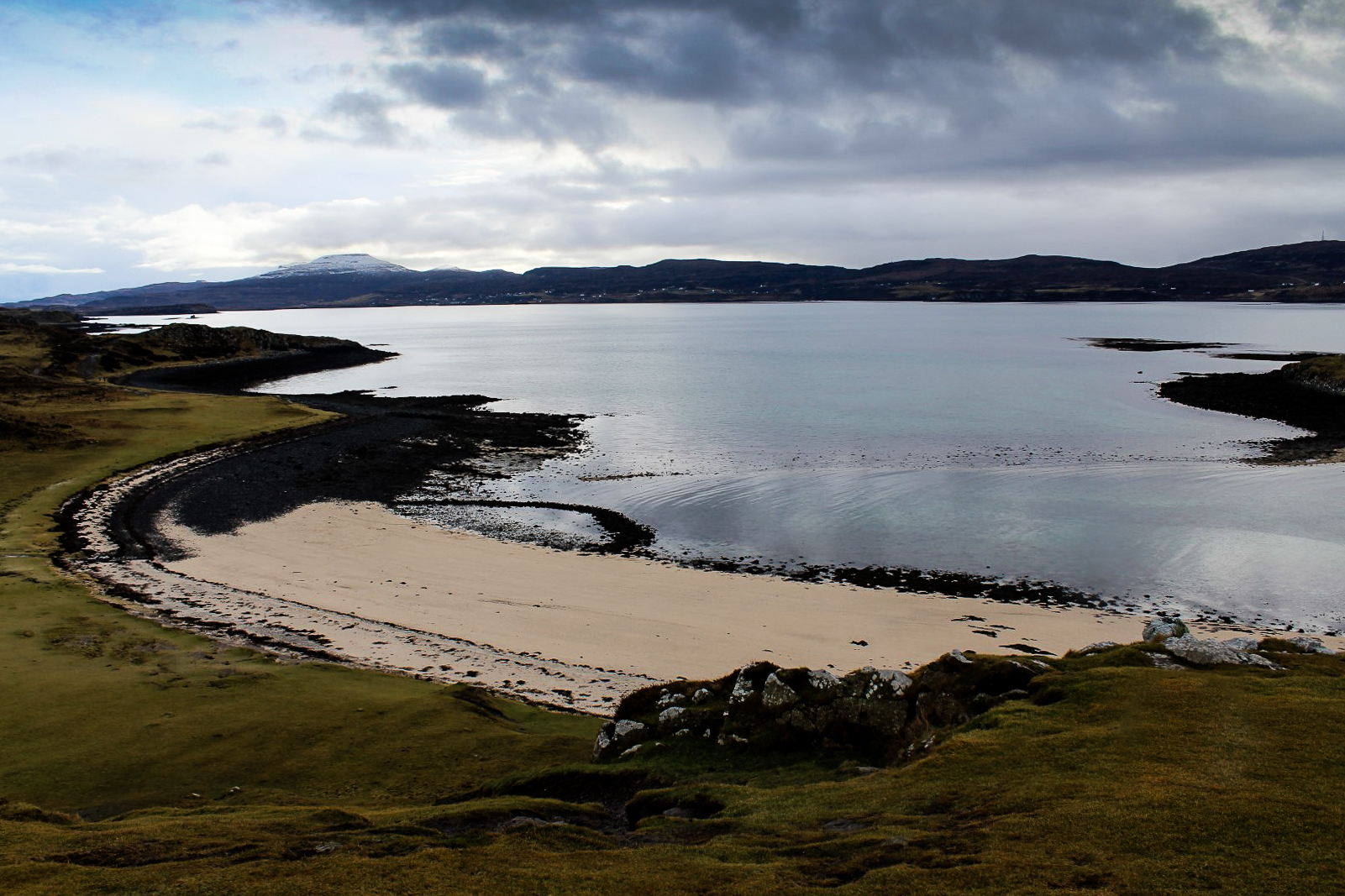
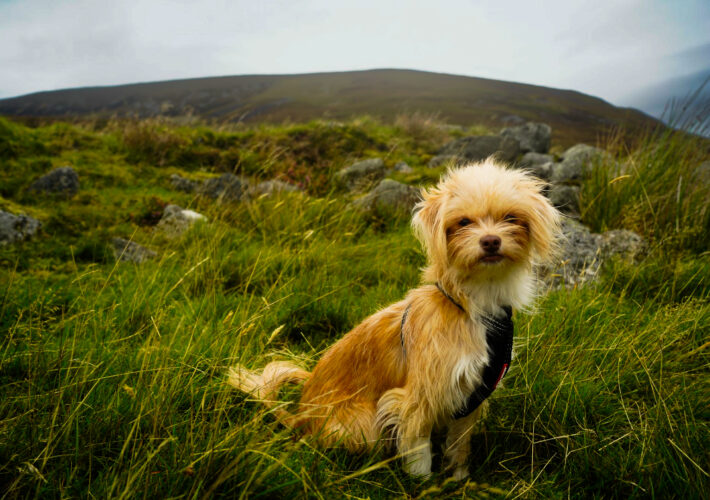

1 COMMENT